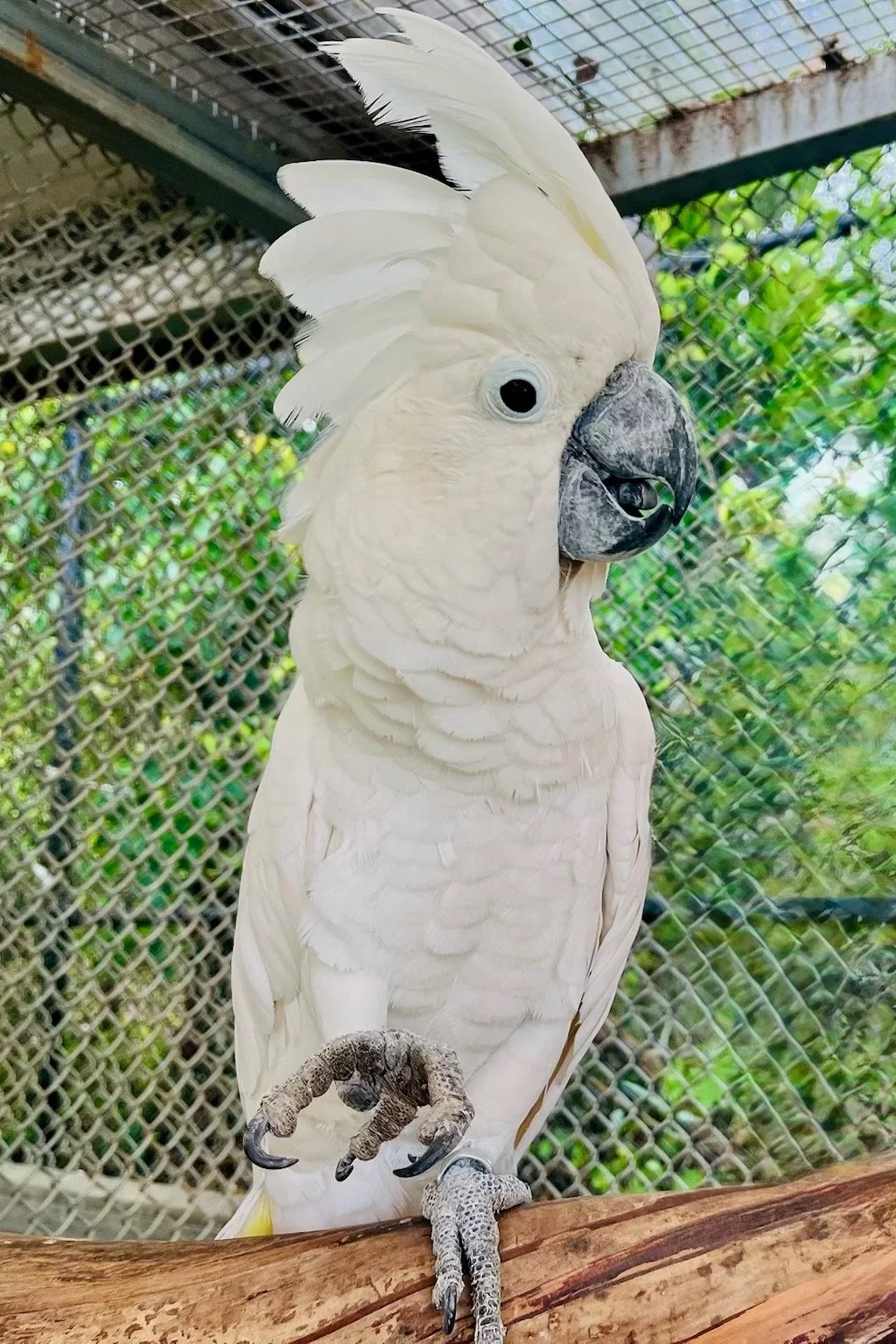Salmon-Crested Cockatoo
Scientific Name: Cacatua Moluccensis
Habitat: Lowland forests
Diet: Herbivore
Weight: 1.87 lbs
Conservation Status: Endangered
Range: South Maluku, Indonesia
Lifespan: 30+ Years
Size: 1.5-1.7 Feet
The Salmon-crested Cockatoo, also known as the Moluccan Cockatoo, is a large parrot native to the Maluku Islands in Indonesia. They are predominantly white with a distinctive salmon-pink wash on their crest, cheeks, and underwings. They have a prominent, expressive crest that they can raise or lower, which often signals their mood. Their strong, curved beaks are adapted for cracking nuts and seeds, and their zygodactyl feet allow them to grasp branches and manipulate food with dexterity. Salmon-crested Cockatoos are highly social and intelligent birds known for their loud calls and strong pair bonds. With voices reaching 129 decibels, they are some of the loudest birds in the world. In the wild, they often form large flocks and engage in playful activities, including vocal mimicry and tool use. Their social structure supports cooperative breeding, and they communicate extensively through vocalisations and body language. During breeding, pairs typically nest in large tree cavities, where the female lays 2 to 3 eggs. Incubation lasts about 25 to 28 days, and the female primarily incubates while the male provides food and protection. Chicks fledge approximately 10 to 12 weeks after hatching.
Yellow Crested Cockatoo
Scientific Name: Cacatua sulphurea
Habitat: tropical and sub-tropical forests
Diet: Omnivore .
Weight: 1.7 lbs
Conservation Status: Least concern
Range: Eastern Australia, Indonesia, Papua New Guinea
Lifespan: 20-40 yrs; up to 70 i captivity
Size: 17'“-22” long
The Yellow-crested Cockatoo is a small to medium-sized cockatoo species known for its elegant white plumage contrasted by a bright yellow crest, which it raises when alarmed or excited. It has a pale yellow wash under the wings and tail, dark grey feet, and a grey-black beak adapted for cracking nuts and seeds. Their expressive crest and contrast in coloration make them easily distinguishable from other cockatoos. Yellow-crested Cockatoos are highly social, often forming small flocks or pair bonds in the wild. They are known for their loud, high-pitched calls, strong site fidelity, and intelligence. Breeding usually occurs once per year, with pairs nesting in tree cavities. The female lays 2–3 eggs, which are incubated for about 28 days, primarily by the female. Chicks fledge at around 10 to 12 weeks, and remaining dependent for several weeks after leaving the nest.
These birds are very intelligent and very curious. Living within the Australian suburbs, they have learned how to open garbage cans to find food! Studies shown they can find a beat to dance to music. They use their feathers to make facial expressions.
Umbrella Cockatoo
Scientific Name: Cacatua alba
Habitat: Lowland tropical forests, mangroves, secondary forests, sometimes cultivated areas
Diet: Omnivore
Weight: 0.9-1.75 lbs
Conservation Status: Endangered
Range: Maluku Islands, Indonesia
Lifespan: 30+ Years
Size: 1.5-1.7 Feet
The Umbrella Cockatoo, also known as the White Cockatoo, is a large, visually striking parrot native to the northern Maluku Islands of Indonesia. It is named for its impressive, fan-shaped crest, which it raises in a dramatic, umbrella-like display when alarmed, excited, or showing affection. The bird’s feathers are almost entirely white, with a slight yellowish tinge under the wings and tail. Its strong, curved black beak, dark eyes, and grey feet add to its distinct appearance. In the wild, Umbrella Cockatoos are social, intelligent, and vocal, often forming monogamous pair bonds or gathering in small flocks. Their behaviors include mutual preening, loud calls used for communication and territory marking, and play using objects or branches. Breeding typically occurs during the dry season. Pairs nest in tree cavities, where the female lays 1 to 3 eggs, incubated for about 28 days. Both parents share incubation duties and feed the chicks, which fledge at around 10 to 12 weeks but may remain dependent for months afterward
Goffin’s Cockatoo
Scientific Name: Cacatua goffiniana
Habitat: Lowland/secondary forests, cultivated areas
Diet: Omnivore
Weight: 8.5-10.5 oz
Conservation Status: Near threatened
Range: Tanimbar Islands, Indonesia
Lifespan: 35-65 Years
Size: 12.5”-15”
The Goffin’s Cockatoo, also known as the Tanimbar Corella, is a small, stocky white cockatoo. It is characterized by white plumage, a slight pink or salmon wash around the beak and base of the feathers, and pale yellow under the wings and tail. This species has a short, rounded crest, a light grey beak, and dark grey legs. Goffin’s Cockatoos are highly intelligent and social, known for their problem-solving skills and capacity for tool use. In the wild, they are typically found in small flocks or pairs, often foraging in forests, mangroves, and agricultural lands. They use their strong beaks to manipulate and break open food. They are also known for their vocalizations, which include high-pitched screeches used for communication and alert. Breeding typically occurs in the dry season, with pairs nesting in tree cavities. The female usually lays 2 to 3 eggs, incubated for approximately 26 to 28 days. Both parents participate in chick rearing, and the young fledge after 8 to 10 weeks, remaining dependent for a period thereafter.



